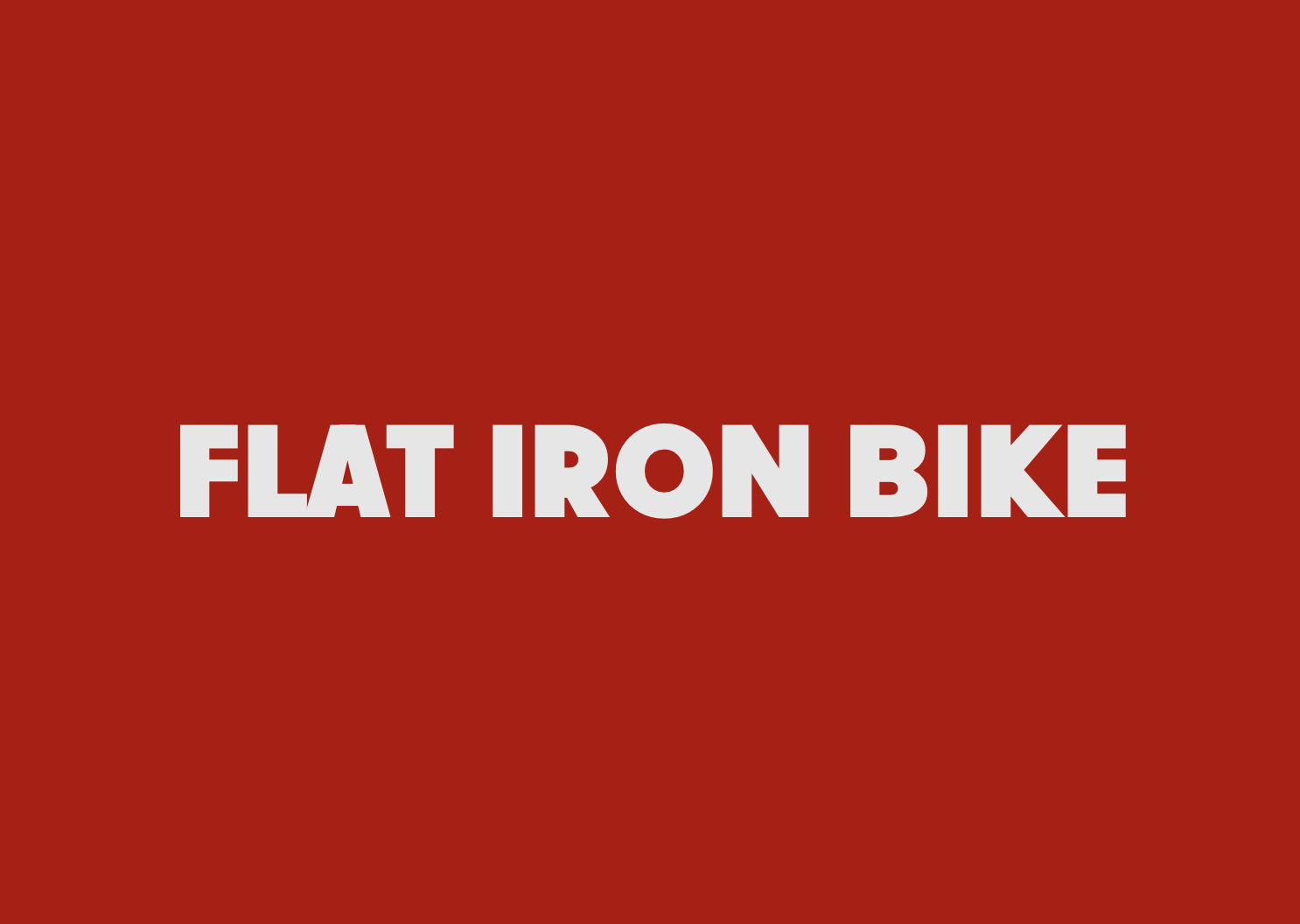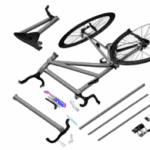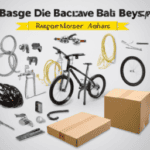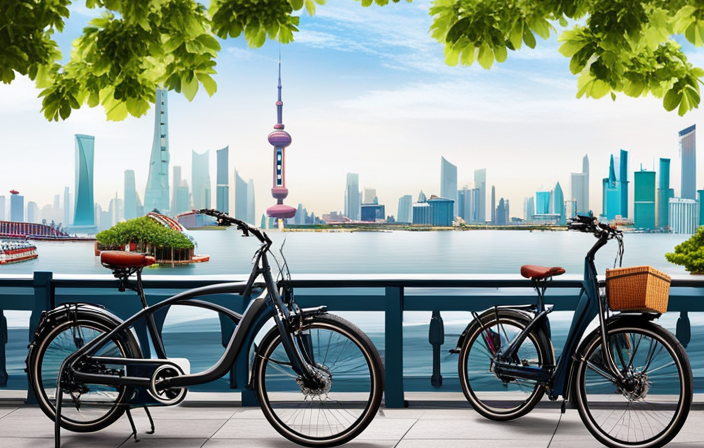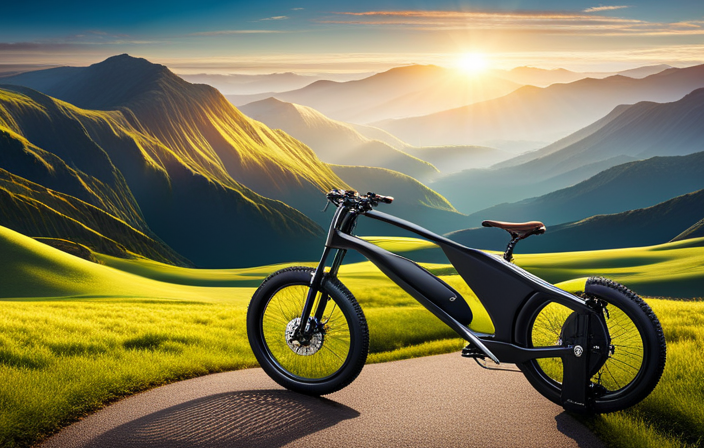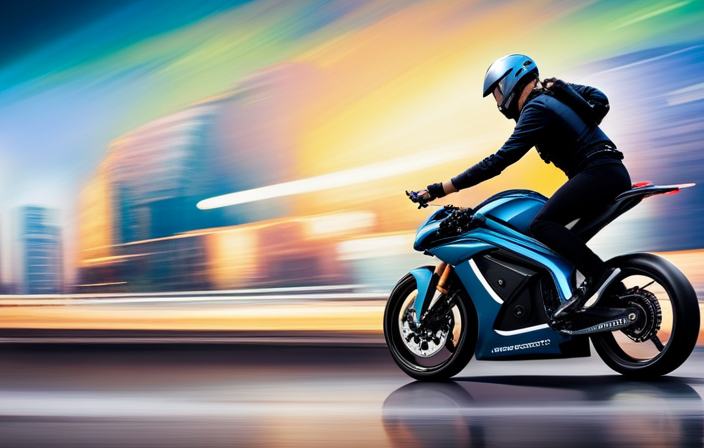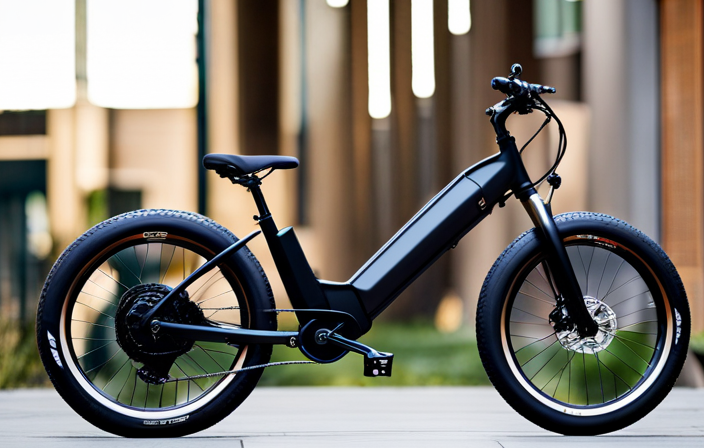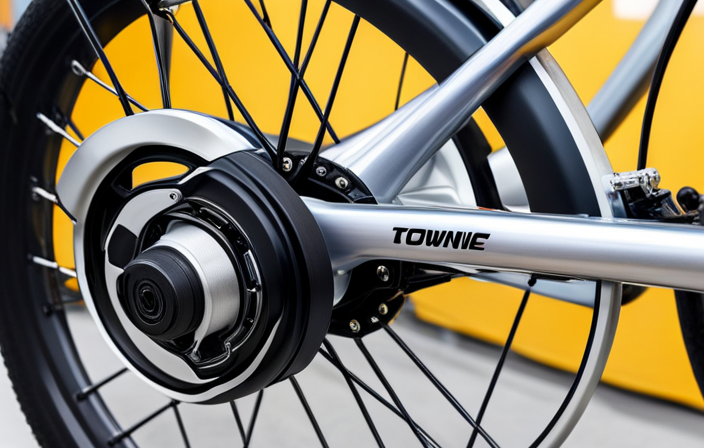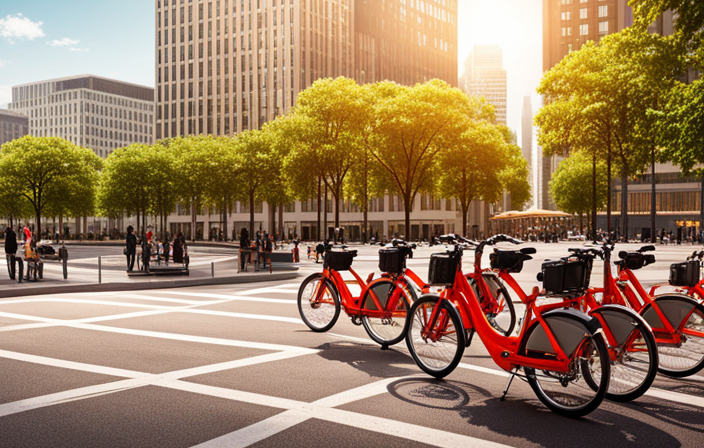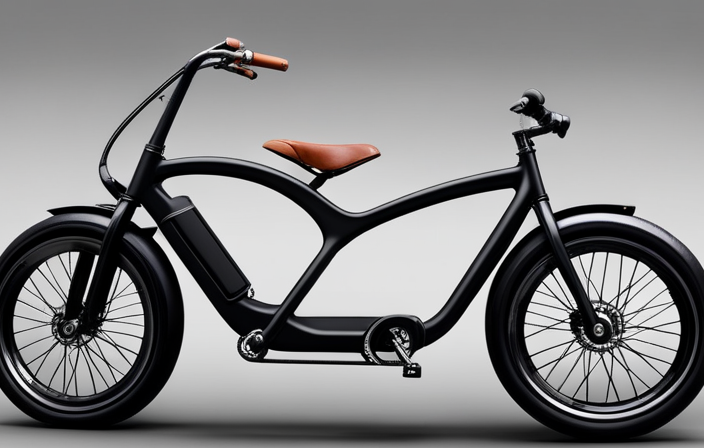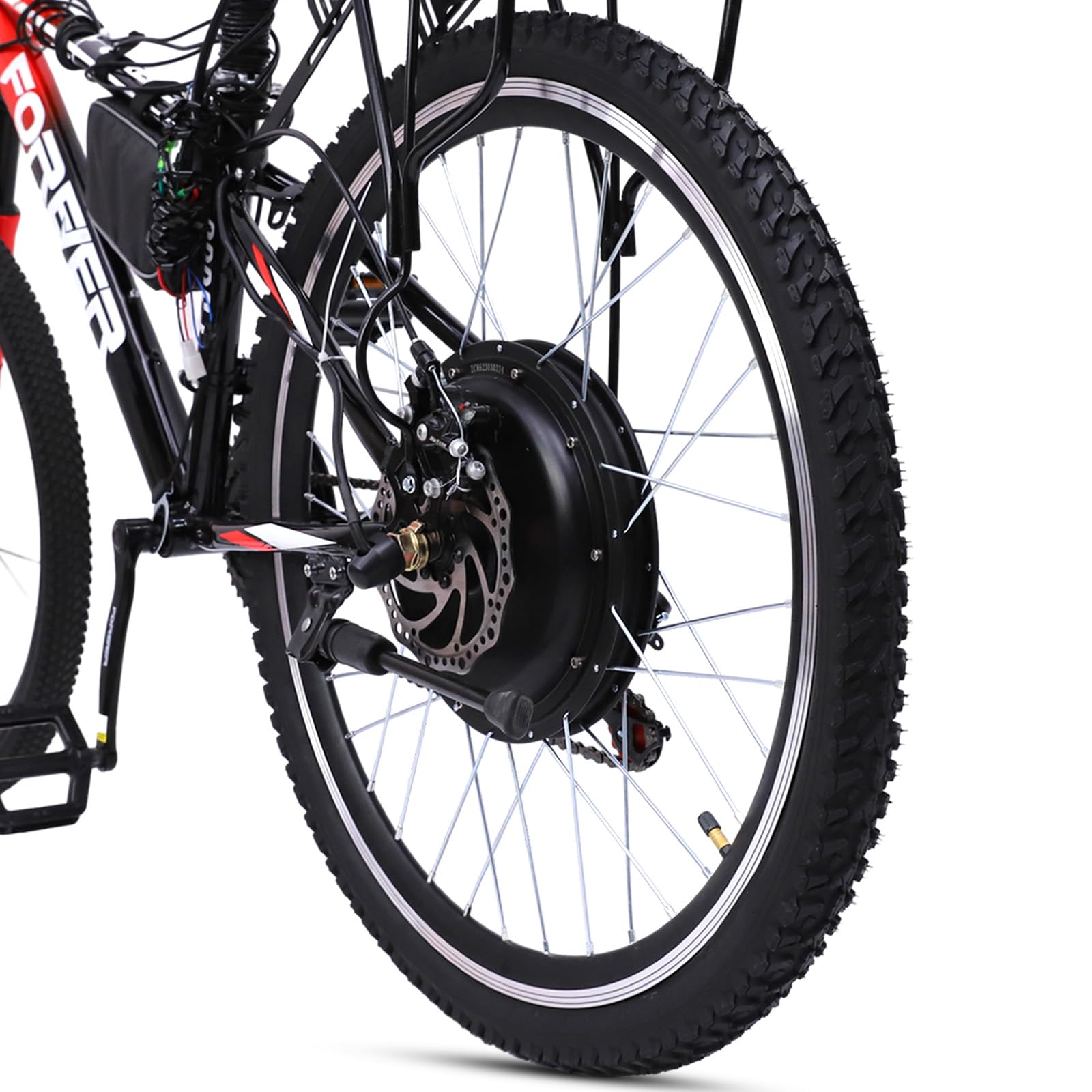Bike
How To Fly With A Bicycle

Traveling by plane with a bicycle can seem daunting, but with proper preparation and insight, it can turn into a smooth experience. Having taken my bicycle on flights numerous times myself, I’ve picked up several helpful hints that can simplify the process.
In this article, I will share my experience and expertise on how to fly with a bicycle, from researching airline policies and fees to assembling and testing your bike upon arrival.
The first step in flying with a bicycle is to research the airline policies and fees. Each airline has different rules and regulations when it comes to transporting bikes, and it’s important to know these before booking your ticket. Some airlines may require you to pack your bike in a specific bag or box, while others may allow you to check it in as is. Additionally, there may be extra fees for transporting a bike, so it’s important to factor these into your travel budget.
By doing your research beforehand, you can avoid any surprises or setbacks at the airport.
Key Takeaways
- Research airline policies and fees before booking a flight with your bike.
- Choose the right bike bag – soft cases offer flexibility, while hard cases provide more protection. Renting is cost-effective for occasional trips, while purchasing is worthwhile for frequent travelers.
- Properly prepare your bike for travel by disassembling, cleaning, and inspecting components, and labeling the bag with your name, address, and flight information.
- Be aware of airline policies and fees for traveling with bikes, arrive early for check-in and security, and be prepared to pay additional fees. Assemble the bike correctly after the flight and adjust for comfort and control.
Research Airline Policies and Fees
You’ll want to check out each airline’s policies and fees for flying with a bicycle, so you don’t get hit with any unexpected charges or restrictions. Start by comparing fees across different airlines to find the most affordable option.
Some airlines charge a flat fee for transporting a bicycle, while others charge based on weight or size. It’s important to also check if there are any additional fees for oversized luggage or if the bike needs to be disassembled before being checked in.
Another important factor to consider is finding discounts. Some airlines offer discounts for members of cycling organizations or for booking early. It’s also worth checking if your credit card offers any perks for flying with a bicycle.
By doing your research and comparing fees, you can save money and ensure a smooth experience when flying with your bike. Now, let’s move on to the next step and choose the right bike bag or box.
Choose the Right Bike Bag or Box
When it comes to choosing the right bike bag or box for air travel, there are two main options to consider: soft cases and hard cases. Soft cases offer more flexibility in terms of storage and often come with additional features such as backpack straps for easy carrying. On the other hand, hard cases provide more protection for your bike but can be heavier and more cumbersome to transport.
Another important factor to consider is whether to rent or buy the bike bag or box. Renting can be a cost-effective option for occasional trips, but purchasing your own bag or box can be a worthwhile investment for frequent travelers.
Soft vs. Hard Cases
Packing your bike for a flight is like choosing between a suit of armor or a cozy sweater: hard cases provide more protection, but soft cases offer more flexibility.
Soft cases are made of durable, lightweight materials that offer more give than hard cases. This means you can fit more items inside the bag, including clothing and other gear. Soft cases are also easier to store when not in use, as they can be folded or rolled up for compact storage.
On the other hand, hard cases provide the ultimate protection for your bike during transit. They are made of tough, impact-resistant materials that can withstand rough handling. Hard cases also have additional features such as reinforced corners and locking mechanisms that ensure your bike stays safe and secure. However, hard cases can be heavier and more cumbersome to transport, and may not fit all types of bikes.
When it comes to choosing between a soft case and a hard case, it really depends on your specific needs and preferences. If you prioritize flexibility and ease of use, a soft case may be the better option. If you prioritize maximum protection for your bike, a hard case may be the way to go.
Now that you’ve chosen your bike bag or box, it’s time to decide whether to rent or buy one for your trip.
Renting vs. Buying
Opting for renting a bike bag or box instead of purchasing one may be a wise decision depending on your travel frequency and storage space. Here are the pros and cons of renting versus buying:
| Pros | Cons | |
|---|---|---|
| Renting | – Lower cost upfront – No need for storage – Access to a variety of cases |
– Limited rental availability – Potential for damage fees – Inconvenient to rent for frequent travelers |
| Buying | – Long-term cost savings for frequent travelers – Convenience of storing and using at any time – Ability to customize case for your bike |
– Higher upfront cost – Requires storage space – Limited options for customization |
A cost comparison is also important to consider. Renting a bike bag or box typically costs between $50-$150 per trip depending on the rental company and type of case. If you travel frequently, these costs can add up quickly. On the other hand, purchasing a case can range from $200-$1000, with the higher end cases providing better protection for your bike. However, if you travel frequently, the long-term cost savings may outweigh the initial investment.
To prepare your bike for travel, there are a few steps you should take.
Prepare Your Bike for Travel
Like a marathon runner stretching before a race, it’s important to give your bike a thorough check-up before flying with it. This means disassembling, cleaning, and inspecting all the components to ensure they’re in good condition.
Start by removing the wheels, pedals, handlebars, and seat post. Use a soft cloth and mild soap to clean the frame, wheels, and other parts. Check the tires for wear and tear, and inflate them to the recommended pressure. Inspect the brakes, gears, and chain, and make necessary adjustments or repairs.
Once your bike is in top shape, it’s time to pack it for travel. Use a sturdy bike box or bag, and make sure the bike is securely fastened inside. Use bubble wrap or foam to protect fragile parts, and add padding around the frame to prevent scratches and dents.
Don’t forget to label the box with your name, address, and flight information. With your bike safely packed, you’re ready to head to the airport. Arrive early to allow plenty of time for check-in and security, and be prepared to pay any additional fees for oversize or overweight luggage.
Arrive Early at the Airport
When traveling with my bike, I always make sure to arrive at the airport early. This way, I have plenty of time to check in, drop off my bike, and clear security without feeling rushed.
Checking in involves presenting my bike as a piece of oversized luggage, while dropping it off typically involves taking it to a designated area or counter.
Once my bike is checked in and dropped off, I then proceed to clear security with my carry-on luggage.
Checking In
Before you head to the airport, make sure you’ve got all the necessary documents and fees required to check in your bicycle for the flight. Online check-in is available in most airlines, so take advantage of it to save time. Make sure to print your boarding pass and baggage tags if needed. If you’re unable to do online check-in, arrive early to the airport and head straight to the check-in counter. Always have your passport and flight reservation ready for the check-in agent.
When checking in your bicycle, the airline will ask you to fill out a baggage declaration form. Here are some things to keep in mind:
- Make sure your bike is packed securely in a bike box or bag
- Remove pedals and turn handlebars sideways to save space
- Deflate tires to reduce the risk of damage
- Double-check the weight limit and any additional fees for oversized baggage
- Keep your bicycle documentations handy in case of any issues during the flight
Once you’ve checked in your bicycle, it’s time to drop it off at the oversized baggage area. Don’t forget to attach your baggage tags and inform the agent that you have a bicycle to drop off.
From here, you’re one step closer to flying with your trusty two-wheeler.
Dropping Off Your Bike
Now that we’ve checked in our bikes, the next step is to drop them off at the designated area for oversize luggage. This is where logistics planning comes into play.
It’s important to know the shipping options available and the fees associated with each one. Some airlines offer free bike transportation as part of their baggage allowance, while others charge a fee for each bike. It’s also important to consider the weight and size of your bike as some airlines have specific restrictions.
Once we’ve determined the shipping option and fees, we can proceed to drop off our bikes. It’s important to have all necessary documents ready, such as the airline’s bike transportation policy and any waivers or release forms required. We should also ensure that our bikes are properly packed and secured to prevent any damage during transportation.
With everything in order, we can confidently drop off our bikes and proceed to clear security.
Transitioning into the subsequent section about ‘clearing security’, it’s important to note that we should always keep our bike documentation and boarding pass handy as we make our way through the security checkpoint.
Clearing Security
As we prepare to pass through security, it’s crucial to keep our important documents in hand and be aware of the potential obstacles we may face. Here are some tips for navigating TSA with a bike:
-
Remove all accessories – Before going through security, make sure to remove all accessories from your bike, such as water bottles, lights, and bags. These items can be packed separately in your carry-on or checked luggage.
-
Use a bike bag – If you’re traveling with your bike, it’s best to pack it in a bike bag. This will protect your bike during transport and make it easier to carry. Make sure to follow TSA guidelines for packing your bike bag.
-
Be prepared for inspection – TSA may need to inspect your bike bag, so make sure to pack it in a way that allows for easy inspection. You may also need to remove your bike from the bag for inspection.
-
Know your airline’s policies – Different airlines may have different policies for traveling with bikes. Make sure to check with your airline before traveling to avoid any surprises at the airport.
When clearing security, it’s important to be prepared and follow the rules to avoid any delays or issues.
Once you’ve successfully passed through security, it’s time to assemble and test your bike upon arrival.
Assemble and Test Your Bike Upon Arrival
Congratulations, you’ve finally arrived at your destination and have the pleasure of putting together your beloved bike while everyone else is enjoying their vacation. Assembling your bike requires patience, attention to detail, and of course, proper tools. Before you start, make sure you have all the necessary tools such as hex wrenches, a pedal wrench, and a torque wrench. These tools will make the assembly process seamless and prevent any damage to your bike’s components.
Once you have all the tools, it’s time to start assembling your bike. Follow the steps below and refer to the table for guidance on assembling your bike properly. It’s crucial to ensure that your bike is assembled correctly to avoid any accidents or damage during your ride. If you’re unsure about the assembly process, you can always consult local bike shops or consider bike rentals. Assembling your bike and getting it ready for your ride is an exciting and rewarding experience that will make your journey even more enjoyable.
| Step | Description |
|---|---|
| 1 | Install the handlebars onto the stem and tighten the bolts to the recommended torque |
| 2 | Install the front wheel, making sure it’s aligned properly with the fork and the quick release is tight |
| 3 | Install the seat post and saddle, adjusting the height to your preference |
| 4 | Install the pedals, making sure the left pedal is screwed in counterclockwise and the right pedal clockwise |
| 5 | Check the brakes, ensuring they’re centered, aligned, and functioning correctly |
| 6 | Inspect the gears, making sure they’re shifting smoothly and the chain is lubricated |
| 7 | Inflate the tires to the recommended pressure, using a pump with a pressure gauge |
| 8 | Take a test ride, adjusting the saddle and handlebars as needed for comfort and control |
Frequently Asked Questions
Can I bring my bike on any airline or are there certain airlines that don’t allow it?
I’ve found that airline restrictions vary when it comes to bringing a bike. Some airlines allow it as a checked-in item while others require it to be disassembled and packed. If not an option, alternative transportation options may be necessary.
What types of fees can I expect when traveling with my bike?
Bike transport fees and airline restrictions vary, so research beforehand. Packing tips and bike disassembly can save money and hassle. As an experienced traveler, I suggest preparing thoroughly to avoid unexpected costs and delays.
How do I ensure that my bike is packed securely in the bag or box?
To ensure bike safety while flying, proper padding and securing straps are crucial. DIY bike packing requires attention to detail, such as removing pedals and handlebars, and packing them separately. Tighten all bolts and wrap fragile areas with protective materials.
Are there any specific tools or items I need to bring in order to assemble my bike upon arrival?
In order to assemble my bike upon arrival, I need a set of Allen keys, tire pump, and possibly a pedal wrench. The assembly process includes attaching the handlebars, pedals, wheels, and adjusting the brakes and gears.
What if my bike is damaged during the flight, what should I do?
If my bike is damaged during a flight, I immediately inspect it and take photos. Then, I notify the airline and file a claim for compensation. It’s important to have insurance options to cover any damages.
Conclusion
Flying with a bicycle can be a daunting task, but with the right preparation, it can be a breeze. After thoroughly researching airline policies and fees, I chose the right bike bag for my trip.
I made sure to prepare my bike for travel by removing pedals, lowering the seat, and protecting delicate parts with padding and foam. When arriving at the airport, I made sure to allow plenty of time for check-in and security.
Assembling and testing my bike upon arrival was also crucial in ensuring a smooth ride. I highly recommend double-checking all bolts and screws before taking off. Overall, flying with a bicycle may seem intimidating, but with the right preparation and attention to detail, it can be a great adventure.
As they say, "a stitch in time saves nine,"and this couldn’t be more true when it comes to flying with a bike. Taking the time to properly prepare and pack your bike will ultimately save you time and money in the long run.
Happy travels!
Bike
How To Motorize A Bicycle
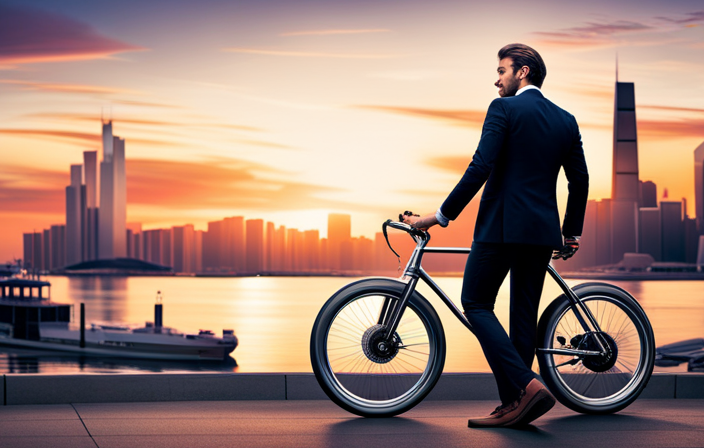
Imagine elevating your cycling experience by transforming your ordinary bicycle into a powerful machine that effortlessly propels you forward.
In this article, I will guide you through the detailed process of motorizing your bicycle, step by step. From choosing the right motor kit to ensuring safety measures, you will learn everything you need to know to create your very own motorized bicycle.
Get ready to embark on an exciting journey of innovation and adventure.
Key Takeaways
- Familiarize yourself with local laws and regulations
- Understand the required equipment for riding
- Learn where motorized bicycles are allowed
- Avoid legal issues by following regulations
Choose the Right Motor Kit for Your Bicycle
You should choose the right motor kit for your bicycle. Choosing the right motor kit can greatly enhance your riding experience and make your commute more efficient.
When considering motor power, factors such as terrain, weight, and desired speed need to be taken into account. For hilly terrains or heavier bicycles, a higher motor power will be required to ensure smooth operation and adequate speed. On the other hand, if you plan to use your motorized bicycle mainly on flat surfaces, a lower motor power may suffice.
Additionally, when it comes to battery capacity, it is important to explore the different options available and choose the right capacity based on your riding needs and distance requirements. A larger battery capacity will allow for longer rides without needing to recharge.
Now that we have discussed choosing the right motor kit, let’s move on to gathering the necessary tools and materials for the installation process.
Gather the Necessary Tools and Materials
To get started, it’s important to gather all the tools and materials needed for the project. Here are the essential items you’ll need:
- Wrench set: You’ll need a set of wrenches to loosen and tighten bolts on your bicycle.
- Screwdriver set: A variety of screwdrivers will be necessary for removing and installing parts.
- Wire cutter/stripper: This tool will come in handy when dealing with electrical connections.
- Allen wrench set: Many motor kits require the use of Allen wrenches for assembly.
- Battery and charger: Make sure to choose a battery that is compatible with your motor kit.
- Motor kit: This is the heart of your motorization project. Choose a kit that suits your needs and budget.
Choosing the right motor kit is crucial to ensure a smooth installation process. Additionally, be prepared to troubleshoot common motorization issues that may arise during the project.
Once you have gathered all the necessary tools and materials, you can proceed to prepare your bicycle for motorization by following the next steps.
Prepare Your Bicycle for Motorization
Before starting, make sure that your bike is in good condition and ready for the motor installation. Inspect the frame, wheels, and brakes for any signs of damage or wear. Check the tire pressure and ensure that they’re properly inflated.
Remove any accessories or attachments that may interfere with the motor installation process.
Next, determine the type of bike modification you want to do, whether it’s a gas-powered engine or an electric bike conversion. This will dictate the specific steps and materials needed for the motorization process.
Additionally, make sure you have all the necessary tools and equipment on hand.
Once your bike is prepared, you can move on to the next section and install the motor kit onto your bicycle, transforming it into a motorized ride.
Install the Motor Kit onto Your Bicycle
Once the motor kit is installed onto your bike, it will be transformed into a motorized ride. To install the electric motor, begin by removing the rear wheel from the bicycle frame. Next, attach the motor bracket onto the frame using the provided screws and secure it tightly. Place the motor onto the bracket, aligning the mounting holes, and fasten it securely. Connect the motor’s wiring to the battery and controller according to the provided instructions, ensuring proper connections. Once everything is connected, double-check all the connections and tighten any loose screws. To troubleshoot motor issues, refer to the troubleshooting section in the motor kit manual. Now, we can move on to the next step and connect the motor to the bicycle’s drive system, allowing it to propel the bike forward effortlessly.
Connect the Motor to the Bicycle’s Drive System
Now you can connect the motor to your bike’s drive system and start enjoying effortless propulsion.
To connect the motor to the bicycle’s drivetrain, follow these steps:
- First, locate the motor mounting bracket on your bike frame. Ensure it is securely attached.
- Next, align the motor’s sprocket with the bike’s chainring. Use a chain tool to remove the necessary links from the bike’s chain if needed.
- Connect the motor’s sprocket to the bike’s chainring using a chain connector.
- Double-check the alignment and tension of the chain. Ensure it is neither too loose nor too tight.
- Once connected, test the motor by pedaling the bike. The motor should engage and provide assistance.
If you encounter any issues during this process, such as chain slipping or misalignment, consult the motor kit’s troubleshooting guide for assistance.
With the motor now connected to the bicycle’s drive system, we can move on to installing the throttle and control mechanisms.
Install the Throttle and Control Mechanisms
To begin the installation process, attach the throttle and control mechanisms to your bike’s handlebars. The throttle allows you to control the speed of the motor, while the control mechanisms enable you to activate the motor and make necessary adjustments. Proper installation of these components is crucial for a smooth and efficient motorization system.
Below is a table that illustrates the installation steps for the throttle and control mechanisms:
| Step | Procedure |
|---|---|
| 1 | Position the throttle grip on the handlebars and secure it using the provided clamp. |
| 2 | Connect the throttle cable to the motor. Ensure a secure and tight connection. |
| 3 | Adjust the throttle sensitivity according to your preference using the provided throttle adjustment feature. |
Once the throttle and control mechanisms are securely installed, you can proceed to test and adjust the motorization system. This will ensure that everything is functioning properly and any troubleshooting issues can be resolved before hitting the road.
Transitioning into the next section, it is important to thoroughly test and adjust the motorization system to guarantee optimal performance.
Test and Adjust the Motorization System
After securely installing the throttle and control mechanisms, it is essential to thoroughly test and adjust the motorization system for optimal performance. Here are the steps to follow:
-
Testing the Motor: Start by engaging the motor and observing its response. Ensure it starts smoothly and accelerates without any hitches. Listen for any unusual noises or vibrations.
-
Adjusting Motor Performance: Fine-tune the motor’s power output by adjusting the throttle. Increase or decrease the throttle sensitivity to achieve the desired speed and responsiveness.
-
Troubleshooting Common Motorization Issues: Monitor the motor for overheating or excessive battery drain. Inspect all connections for loose wires or faulty components. Resolve any issues promptly to prevent further damage.
-
Test Ride and Fine-tuning: Take the motorized bicycle for a test ride, paying attention to its overall performance and handling. Make any necessary adjustments to the motor or control mechanisms to improve the riding experience.
Now that the motorization system has been tested and adjusted, it is crucial to ensure safety measures are in place for worry-free riding.
Ensure Safety Measures are in Place
Make sure you have all the necessary safety measures in place to ensure a worry-free riding experience. The importance of wearing protective gear cannot be emphasized enough when motorizing a bicycle. A helmet, knee pads, and elbow pads are essential to protect yourself from potential accidents and injuries.
Additionally, it is crucial to understand and abide by local laws and regulations regarding motorized bicycles. Different jurisdictions may have specific rules about speed limits, required equipment, and where motorized bicycles are allowed to be ridden. Familiarize yourself with these regulations to avoid any legal issues.
By prioritizing safety and following the rules, you can enjoy the benefits of a motorized bicycle without compromising your well-being or breaking the law.
Now, let’s move on to learning how to operate and maintain your motorized bicycle smoothly.
Learn How to Operate and Maintain Your Motorized Bicycle
Learning how to operate and maintain your motorized bike is essential for a smooth and hassle-free riding experience. To ensure that your motorized bicycle functions optimally, here are three key tips:
-
Troubleshooting common issues with motorized bicycles: Familiarize yourself with common problems such as engine starting issues, fuel system malfunctions, or electrical failures. This knowledge will help you diagnose and fix problems efficiently.
-
Tips for increasing the lifespan of your motorized bicycle: Regularly check and change the engine oil, clean the air filter, and inspect the spark plug. Additionally, avoid overloading the bike and adhere to the manufacturer’s recommended maintenance schedule.
-
Properly maintaining the bike’s components: Regularly lubricate the chain, inspect the brakes, and ensure the tires are inflated to the correct pressure. These simple maintenance tasks will ensure your motorized bicycle performs at its best.
By following these guidelines, you can enjoy the benefits of your motorized bicycle without any interruptions.
Enjoy the Benefits of Your Motorized Bicycle
To fully experience the advantages of your motorized bike, you’ll love the increased speed and convenience it brings to your daily commute.
Riding a motorized bicycle in your daily commute has numerous benefits. Firstly, it allows you to travel at a faster pace, reducing travel time and making your commute more efficient. With the added power of the motor, you can easily navigate through traffic and reach your destination faster.
Additionally, using a motorized bicycle is a sustainable and eco-friendly option, reducing your carbon footprint and contributing to a cleaner environment.
To ensure the longevity of your motorized bicycle, it is essential to follow best practices for maintenance. Regularly inspect and clean the bike, check tire pressure, and lubricate the chain. Proper maintenance will not only enhance the performance but also extend the lifespan of your motorized bicycle, allowing you to enjoy its benefits for years to come.
Frequently Asked Questions
How much does a motor kit for a bicycle typically cost?
Motor kits for bicycles typically range in cost from around $200 to $1500, depending on the type of motor. There are various types available, including electric hub motors and mid-drive motors.
Are there any legal requirements or restrictions for using a motorized bicycle?
Sure, let’s dive into the legal requirements and restrictions for using a motorized bicycle. In terms of registration, it depends on your location, but some places require you to register your motorized bicycle. As for speed limits, again, it varies, but typically motorized bicycles are subject to the same speed limits as regular bicycles.
Can any type of bicycle be motorized, or are there specific requirements?
Any type of bicycle can be motorized, but there are specific requirements. Motorizing mountain bikes involves adding a motor and battery to the frame, while converting road bikes requires installing a motor kit onto the existing bike.
What kind of maintenance is required for a motorized bicycle?
Maintenance tips for a motorized bicycle include regular oil changes, checking spark plugs, and inspecting the chain for wear. Troubleshooting common issues such as starting problems or strange noises may require adjusting the carburetor or cleaning the fuel system.
Are there any safety concerns or precautions to be aware of when operating a motorized bicycle?
Motorized bicycle safety concerns are critical to understand. It is essential to prioritize safety precautions, such as wearing a helmet, using reflectors, maintaining brakes, and following traffic rules, to ensure a safe and enjoyable ride.
Conclusion
In conclusion, as I reflect on my journey of motorizing my bicycle, I can’t help but feel a sense of liberation and excitement.
Like a phoenix rising from the ashes, my bicycle has transformed into a powerful steed, ready to conquer any path ahead.
The precision and attention to detail required in this process have not only enhanced my technical skills but also my appreciation for the beauty of mechanics.
Now, as I ride into the sunset, I am filled with a sense of pride and joy, knowing that I have unlocked a new world of possibilities with my motorized companion.
Bike
How To Change Gears On A Gravel Bike
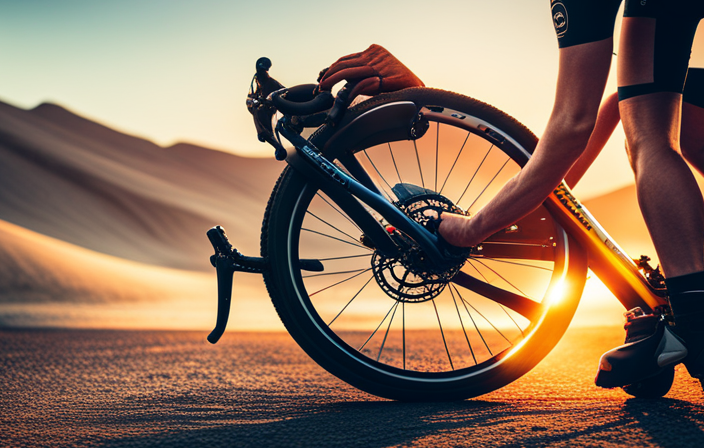
Prepare yourself to enhance your gravel biking abilities with this in-depth guide on mastering gear changes like a professional.
Mastering the art of gear shifting is crucial for any cyclist, especially when tackling unpredictable terrains.
In this article, I will walk you through the ins and outs of understanding your bike’s gear system, perfecting your technique, troubleshooting common issues, and ultimately enjoying a smooth ride with perfectly timed gear changes.
So grab your helmet and let’s dive in!
Key Takeaways
- Gravel bikes have a wide range of gears for different terrains.
- Proper gear shifting technique ensures a smooth and efficient ride.
- Familiarize yourself with the gear levers and their correct operation.
- Choose the correct gear ratio based on the anticipated terrain changes.
Understanding the Gear System on a Gravel Bike
To change gears on your gravel bike, you’ll need to understand the gear system. The gear selection on a gravel bike is crucial for optimizing performance and ensuring a smooth ride on various terrains.
Gravel bikes typically come with a wide range of gears to accommodate different riding conditions, including steep climbs and fast descents.
One important aspect of the gear system is the gear ratios. Gear ratios determine how much power is transferred from your legs to the wheels. Higher gear ratios provide more power but require more effort, making them suitable for flat or downhill sections. Lower gear ratios, on the other hand, offer less power but are easier to pedal, making them ideal for climbing steep hills or navigating rough terrain.
Understanding how to select the right gear ratio for each situation is essential in maximizing efficiency and preventing unnecessary strain on your body. By choosing an appropriate gear ratio, you can maintain a consistent cadence while adapting to changes in terrain without exerting excessive force.
Proper gear shifting technique plays a vital role in achieving seamless transitions between gears without interruption or damage to the drivetrain components.
Importance of Proper Gear Shifting Technique
Remember, it’s crucial to use the correct technique when shifting gears on your gravel bike. Proper gear shifting technique not only ensures a smoother and more efficient ride but also prevents unnecessary wear and tear on your drivetrain. By following these guidelines, you can optimize your gear shifting experience and reap the benefits of efficient gear shifting.
One key aspect of proper gear shifting technique is timing. It’s important to anticipate shifts in terrain or cadence and initiate gear changes before they become necessary. This allows for a seamless transition between gears, minimizing any disruption to your pedaling rhythm.
Another important factor is maintaining consistent pedal pressure while shifting gears. Applying too much force when changing gears can cause the chain to jump or slip, leading to potential damage. On the other hand, releasing pedal pressure entirely can result in a loss of momentum. Finding the right balance between applying pressure and easing up slightly will ensure a smooth transition from one gear to another.
To further emphasize this point, consider the following table:
| Gear Shifting Technique | Benefits |
|---|---|
| Anticipating shifts | Smoother transitions |
| Consistent pedal pressure | Prevents chain slippage |
| Balancing pressure | Maintains momentum |
By implementing these techniques, you’ll experience improved efficiency and durability in your gravel biking adventures.
Transitioning into the subsequent section about familiarizing yourself with the gear levers, it’s essential to understand how they function to make precise gear changes effortlessly.
Familiarize Yourself with the Gear Levers
Before getting started, it’s important to know how the gear levers on your gravel bike work. Familiarizing yourself with the gear lever functions and proper hand placement will ensure smooth and efficient gear shifting while riding.
Most gravel bikes are equipped with a combination of two gear levers, one for controlling the front derailleur and the other for the rear derailleur. The left lever is responsible for shifting between the chainrings, which control the bike’s front gears. On the other hand, the right lever controls the rear gears by moving the derailleur across different cogs on the cassette.
To shift gears using these levers, place your hands firmly on both hoods of your handlebars. Your index fingers should rest lightly on top of each lever, ready to initiate shifts when needed. When you want to shift to an easier gear (a smaller cog or a smaller chainring), push either lever sideways using your thumb or index finger. For harder gears (larger cogs or larger chainrings), pull back on either lever.
Understanding how to operate these gear levers and maintaining proper hand placement is crucial in achieving optimal performance and preventing any potential damage to your gravel bike’s drivetrain components.
With this knowledge in mind, let’s move onto starting with the right gear ratio…
Start with the Right Gear Ratio
Begin with the correct gear ratio to ensure optimal performance and prevent potential damage to your drivetrain components. Gear selection is crucial when changing gears on a gravel bike. By choosing the right gear ratio, you can maximize efficiency and power transfer while minimizing unnecessary strain on your bike’s components.
To start with the right gear ratio, it’s important to consider the terrain you’ll be riding on. If you’re facing a steep climb or challenging off-road section, it’s best to select a lower gear that provides more torque for easier pedaling. On the other hand, if you’re riding on flat or downhill sections, choosing a higher gear will allow you to maintain speed without excessive spinning of the pedals.
Finding the ideal gear ratio may require some trial and error, especially when encountering varying terrains during your ride. Pay close attention to how your bike responds to different gears and adjust accordingly. Anticipate terrain changes by smoothly shifting gears before reaching them, ensuring a seamless transition between ratios.
By starting with the right gear ratio and adjusting as needed, you can optimize your gear selection for maximum efficiency and enjoy a smoother ride on your gravel bike. Anticipating terrain changes will further enhance your overall biking experience.
Anticipate Terrain Changes
To optimize your riding experience, it’s important to anticipate shifts in terrain while on your gravel bike. Understanding the terrain and adapting your gear strategy accordingly can greatly enhance your performance and enjoyment. By being proactive in adjusting gears before encountering changes in the landscape, you can maintain a steady cadence and ensure smooth transitions.
To help you understand how to adapt your gear strategy based on terrain, refer to the table below:
| Terrain Type | Recommended Gear Strategy |
|---|---|
| Uphill | Shift to a lower gear for easier pedaling |
| Downhill | Shift to a higher gear for increased speed |
| Flat | Maintain a comfortable gear ratio |
| Loose Gravel | Shift to a lower gear for better traction |
| Sand or Mud | Shift to an even lower gear for stability |
By anticipating these terrain changes and adjusting gears accordingly, you’ll be able to maintain optimal control of your gravel bike. Remember, it’s always better to shift before you need to rather than struggling with shifting under pressure during challenging sections. This will not only improve your overall riding experience but also prevent unnecessary strain on yourself and the bike. Transitioning into the next section about ‘shift before you need to’ will further enhance your understanding of proper gear management on a gravel bike.
Shift Before You Need to
Make sure you shift gears on your gravel bike in anticipation of upcoming terrain changes. Anticipating terrain changes is essential to maintaining a steady pedaling cadence and ensuring a smooth ride.
Here are four crucial tips for shifting gears effectively:
-
Pay attention to the road ahead: Keep your eyes focused on the trail, looking out for any obstacles or changes in terrain that may require gear adjustments.
-
Shift before you need to: Don’t wait until you’re struggling to pedal uphill or losing control on a descent. Shift gears proactively, allowing yourself enough time to adjust smoothly without interrupting your flow.
-
Know your bike’s gear range: Familiarize yourself with the different gear combinations available on your gravel bike. Understand which gears are best suited for climbing, descending, and cruising on flat terrain.
-
Practice shifting techniques: Experiment with shifting both up and down the gears while riding at varying speeds. This will help you develop a feel for how your bike responds and ensure seamless transitions between gears.
Maintaining a steady pedaling cadence is crucial for efficient riding and preventing unnecessary strain or fatigue. Transitioning into the next section about ‘maintain a steady pedaling cadence,’ it is equally important to find the right gear ratio that allows you to maintain an optimal cadence throughout different terrains.
Maintain a Steady Pedaling Cadence
When it comes to changing gears on a gravel bike, one important aspect to consider is maintaining a steady pedaling cadence. This not only helps in improving your efficiency but also ensures a smoother transition between gears.
To maintain cadence, it is crucial to anticipate gear changes and shift before you actually need to. By doing so, you can avoid sudden spikes or drops in resistance that can disrupt your rhythm. Instead, aim for seamless transitions that allow you to keep spinning at a consistent cadence.
Maintaining a steady pedaling cadence has several benefits. Firstly, it reduces the strain on your muscles and joints by distributing the workload evenly across different gears. Secondly, it allows you to generate power consistently without wasting energy due to abrupt gear changes.
By focusing on maintaining cadence while changing gears on your gravel bike, you will find yourself riding with greater efficiency and endurance. So remember, smooth shifts are key!
In the next section about using both front and rear gears, we will explore another essential technique for optimizing gear changes without any interruption in your ride flow.
Use Both Front and Rear Gears
Using both the front and rear gears on your gravel bike is essential for achieving optimal gear changes without any interruption in your ride flow. When it comes to front gear selection, you have multiple options available.
The smaller chainring is ideal for climbing steep hills or tackling difficult terrain, as it provides a lower gear ratio that allows for easier pedaling. On the other hand, the larger chainring is great for riding on flat roads or when you want to go faster, as it offers a higher gear ratio that maximizes your speed.
In terms of rear gear selection, your gravel bike typically has a wide range of gears to choose from. The smaller cogs provide easier pedaling and are perfect for uphill climbs or rough surfaces where you need more control. Conversely, the larger cogs offer higher resistance and are suitable for riding on flat roads or when you want to pick up speed.
By utilizing both front and rear gears effectively, you can optimize your riding experience by seamlessly transitioning between different terrains and conditions. However, it’s important to note that you should avoid ‘cross chaining,’ which refers to using extreme combinations such as the small chainring with the smallest cog or the large chainring with the largest cog. This can cause excessive wear on your drivetrain components and may result in poor shifting performance.
Transitioning into the next section about ‘don’t cross-chain,’ it’s crucial to understand how improper gear selection can negatively impact your ride quality and potentially damage your bicycle’s drivetrain components.
Don’t Cross Chain
Avoiding cross-chaining is important to maintain the performance and longevity of your drivetrain components. Cross-chaining occurs when you use the extreme combination of gears, such as using the big chainring in the front and the biggest cog in the rear, or vice versa. This puts excessive stress on your chain and can lead to premature wear and tear. Additionally, cross-chaining reduces efficiency and can cause poor shifting.
To prevent cross-chaining, it is essential to understand your gear ratios and make conscious decisions when shifting. When riding on a gravel bike, it’s recommended to avoid extreme gear combinations that strain your drivetrain unnecessarily. Instead, aim for a balanced use of gears that allows for smooth transitions between them.
Regularly inspecting and maintaining your gears is also crucial for optimal performance. Clean your drivetrain regularly to remove dirt and grime that can affect shifting quality. Lubricate the chain appropriately to minimize friction.
By avoiding cross-chaining and practicing good gear maintenance habits, you can ensure a longer lifespan for your drivetrain components while optimizing your cycling experience.
Now let’s delve into adjusting gear shifters for comfort without compromising functionality.
Adjusting Gear Shifters for Comfort
To achieve a more comfortable riding experience, it’s important to make adjustments to your gear shifters. Proper gear shifter maintenance and adjusting gear cable tension are crucial for smooth and efficient shifting.
Here are two key steps you can take to optimize the performance of your gear shifters:
- Check and adjust the gear cable tension: Begin by shifting your bike into the highest gear (smallest cog). Locate the barrel adjuster on the derailleur or shifter body. Turn it clockwise to increase tension or counterclockwise to decrease tension until the shifting feels crisp and precise.
- Fine-tune while riding: Take your bike for a spin around a quiet area, such as an empty parking lot. Shift through all gears while paying attention to any hesitation or lag in shifting. If needed, make additional adjustments using the barrel adjuster until you achieve seamless shifting across all gears.
- Evaluate lever position and reach: Ensure that your shift levers are positioned comfortably within reach of your hands while gripping the handlebars. Adjust their angle if necessary, so you can easily access them without straining or stretching.
By maintaining and adjusting your gear shifters correctly, you’ll enhance both comfort and performance on your gravel bike.
Now, let’s move on to practice shifting gears on different surfaces for even greater control during rides without compromising safety or efficiency.
Practice Shifting Gears on Different Surfaces
Start by practicing shifting gears on a variety of surfaces to improve your control and adaptability while riding. It’s important to become familiar with the different gear ratios and how they affect your bike’s performance. Shifting on loose gravel can be particularly challenging, as the surface provides less traction and stability. To navigate this terrain effectively, you need to anticipate changes in resistance and adjust your gears accordingly.
To help illustrate the concept, here is a table showing examples of suitable gear ratios for different surfaces:
| Surface | Gear Ratio |
|---|---|
| Paved road | High gear (big chainring) |
| Gravel road | Medium gear |
| Loose gravel | Low gear (small chainring) |
| Uphill | Low gear |
When shifting on loose gravel, it’s crucial to smoothly transition between gears to avoid any sudden loss of traction. Start by approaching the shift with a steady pedal stroke, then quickly but gently shift into a lower gear before you encounter the loose section. This will allow you to maintain momentum without losing control.
As you practice shifting gears on different surfaces, pay attention to how your bike responds. Listening to your bike can provide valuable feedback about whether you need to make further adjustments or if everything is running smoothly.
Transitioning into the subsequent section about ‘listening to your bike,’ we’ll explore how understanding its cues can enhance your overall riding experience.
Listen to Your Bike
When you’re riding, it’s essential to listen closely to your bicycle for valuable feedback. Your bike can tell you a lot about its condition and how well it’s performing. By paying attention to the sounds it makes, you can detect any potential issues and address them before they become major problems.
Here are some key components of your gear system that you should listen for:
- Chain noise: A noisy chain could indicate that it needs lubrication or that there is excessive wear.
- Gear skipping: If your gears are skipping or jumping when you shift, it may be a sign of misalignment or cable tension issues.
- Grinding sound: This could mean that your drivetrain components are not properly aligned or that there is dirt and debris causing friction.
By regularly listening to these sounds and identifying any abnormalities, you can take proactive steps in bike maintenance to keep your gear system running smoothly.
In the next section, we will discuss fine-tuning your gear shifting skills for an even better riding experience.
Fine-Tuning Your Gear Shifting Skills
Fine-tuning your gear shifting skills can greatly enhance your cycling experience. When it comes to gravel biking, mastering gear shifting techniques is crucial for maintaining control and maximizing efficiency on unpredictable terrain. The key to efficient gear shifting lies in anticipating changes in the trail ahead and adjusting your gears accordingly.
One important technique is preemptive shifting. By planning ahead and shifting into an appropriate gear before you encounter a steep climb or descent, you can maintain momentum and avoid stalling or spinning out. This requires paying close attention to the terrain ahead and using your knowledge of gear ratios to select the optimal gear.
Another technique is called cadence management. Maintaining a consistent pedaling rhythm not only improves efficiency but also reduces strain on your legs. To achieve this, you should shift gears based on your current cadence rather than relying solely on speed or intensity. Experiment with different cadences to find what feels most comfortable for you.
By honing these gear shifting techniques, you can improve your overall performance and enjoyment while riding a gravel bike.
Transitioning now into troubleshooting common gear shifting issues, understanding how to address these problems will ensure a smooth and uninterrupted ride experience without any hiccups along the way.
Troubleshooting Common Gear Shifting Issues
To troubleshoot common gear shifting issues, pay attention to any unusual noises or resistance while pedaling. Here are some common gear shifting problems and how to fix them:
-
Misalignment: If your gears aren’t shifting smoothly, they may be misaligned. To fix this, use the barrel adjuster on your derailleur to make small adjustments until the gears shift smoothly.
-
Chain skipping: If your chain is skipping over the teeth of the cassette or chainring, it could be due to a worn-out chain or cassette. Replace these components if necessary to resolve the issue.
-
Cable tension issues: If your gears aren’t shifting properly, it could be due to incorrect cable tension. Use the barrel adjuster on your shifter or derailleur to fine-tune the cable tension for smooth gear changes.
-
Bent derailleur hanger: A bent derailleur hanger can cause poor shifting performance. Inspect the hanger for any signs of damage and replace if necessary.
By troubleshooting these common gear shifting problems, you can ensure that your gravel bike performs optimally. Enjoy the smooth ride with perfectly timed gear changes in the subsequent section about ‘enjoying the smooth ride with perfectly timed gear changes.’
Enjoy the Smooth Ride with Perfectly Timed Gear Changes
Achieve a smooth and enjoyable ride by mastering the art of perfectly timed gear shifts. When riding a gravel bike, it is essential to have precise control over your gears to navigate various terrains. Perfecting gear transitions allows you to maintain an optimal cadence and power output, ensuring efficiency and comfort throughout your ride.
To achieve perfect gear changes, start by understanding the concept of optimal gear ratios. This involves finding the right balance between the front chainring and rear cassette gears. The goal is to select a combination that provides enough resistance for efficient pedaling without straining your muscles or causing unnecessary fatigue. Experiment with different combinations on different terrains to find what works best for you.
Timing is crucial when shifting gears. Anticipate changes in terrain or gradient ahead of time, allowing yourself ample time to shift smoothly. Avoid shifting under heavy load as this can cause mechanical stress on your drivetrain components. Instead, ease off the pedals momentarily while making the transition.
When executing a gear change, apply steady pressure on the shifter while simultaneously releasing pressure on the pedals momentarily. This allows for smoother shifting as the chain moves from one gear to another seamlessly.
By practicing and perfecting your gear transitions, you will enjoy a smoother ride with optimal power delivery and reduced strain on your body. Remember that mastering this skill takes time and experience, so don’t be discouraged if it doesn’t come naturally at first. Keep experimenting with different techniques until you find what works best for you and enjoy every moment of your gravel bike adventures!
Frequently Asked Questions
What are the different types of gear ratios available on a gravel bike?
There are various gear ratios available on a gravel bike to cater to different riding conditions. Gear ratio selection is crucial as it determines the ease or difficulty of pedaling.
Lower gear ratios, such as 1:1 or 0.8:1, provide more torque for climbing steep hills or navigating rough terrain.
Higher gear ratios, like 2:1 or 2.5:1, offer greater speed on flat surfaces and descents.
Choosing the right gear ratio can optimize efficiency and power output while riding a gravel bike.
How do I know if I’m using the correct gear ratio for a specific terrain?
To determine if you’re using the correct gear ratio for a specific terrain, there are a few factors to consider.
Firstly, observe your cadence (the speed at which you pedal). If it feels too easy or difficult, you may need to adjust the gear ratios accordingly.
Additionally, monitor your speed and power output. If you’re struggling to maintain speed or exerting excessive effort, troubleshooting gear shifting and adjusting gear ratios can help optimize your performance on different terrains.
Can I shift gears while standing up on my gravel bike?
Yes, you can shift gears while standing up on your gravel bike. When climbing steep terrain, it’s important to use the correct shifting technique to maintain momentum and efficiency.
As you approach a climb, anticipate the gear change by slightly easing off the pedals. Then, shift to a lower gear smoothly and quickly, using both your hands and body weight to apply pressure on the pedals.
This will ensure a seamless transition and allow you to conquer those challenging ascents with ease.
How often should I clean and lubricate my gear shifters?
I clean and lubricate my gear shifters regularly to ensure optimal performance and prolong their lifespan.
It is recommended to clean and lubricate the gear shifters every 100-200 miles or whenever they become dirty or sticky.
Start by wiping them down with a damp cloth, then apply a small amount of lubricant to the moving parts.
This will keep the gear shifters functioning smoothly and prevent any unnecessary wear or damage.
Are there any specific techniques for shifting gears smoothly and quickly on a gravel bike?
Shifting gears on a gravel bike requires finesse and precision, much like conducting a symphony. The key is to anticipate the terrain ahead and choose the appropriate gear ratio.
By mastering this art, you can seamlessly transition between gears, ensuring optimum power transfer and a smooth riding experience.
Correct gear ratios allow you to conquer various terrains effortlessly. Whether it’s climbing steep hills or navigating through loose gravel, the right technique is your ticket to gravel biking nirvana.
Conclusion
In conclusion, mastering the art of gear shifting on a gravel bike is essential for a smooth and enjoyable ride.
By understanding the gear system, familiarizing yourself with the levers, and anticipating terrain changes, you can ensure that your gear changes are perfectly timed.
Just like a well-oiled machine, your bike will respond seamlessly to your commands, allowing you to conquer any trail with ease.
So why wait? Embrace the thrill of gravel biking and let your gears dance in perfect harmony as you embark on new adventures.
Bike
What Equipment Must A Bicycle Have When Used At Night?

Like a single bright star in the night sky, a bicycle with the appropriate gear guarantees safe travels once the sun goes down. Being an experienced cyclist, I understand the significance of being visible on the road, particularly during nighttime.
In this article, I will guide you through the essential equipment that every bicycle must have when used at night, from powerful lights and reflectors to reflective clothing and properly inflated tires.
Let’s embark on this journey of knowledge to enhance your nighttime cycling experience.
Key Takeaways
- Reflective gear, such as reflective tape and decals, is essential for increased visibility when cycling at night.
- High-visibility accessories like flags and vests should be used to maximize visibility.
- Properly inflated tires and good tread are important for optimal control and safety.
- Consider the terrain and choose a tread pattern accordingly, and regularly check tire pressure for safe night riding.
White Front Light
You must have a white front light on your bicycle when riding at night. It is essential for your safety and the safety of others on the road.
A white front light helps you see what’s ahead, making sure you can spot any potential hazards, obstacles, or changes in the road surface. Additionally, it allows other road users to see you coming from a distance, reducing the risk of accidents.
A good quality white front light will have a strong beam, illuminating the path ahead effectively. It is important to choose a light that meets the legal requirements for brightness and visibility.
Once you have your white front light secured, the next step is to ensure you have a red rear light, which I will discuss in the next section.
Red Rear Light
A bicycle at night should be equipped with a red rear light. The importance of a red rear light cannot be overstated when it comes to ensuring the safety of both the cyclist and other road users.
Not only does it allow drivers to easily spot the bicycle from a distance, but it also helps them determine the direction in which the cyclist is traveling. In many countries, including the United States, it is a legal requirement for bicycles to have a red rear light when riding at night. This is because it significantly reduces the risk of accidents and enhances visibility.
However, simply having a red rear light is not enough. Reflectors on the front, rear, pedals, and wheels are also crucial in maximizing visibility. These reflectors work in conjunction with the red rear light to make the bicycle more visible from all angles and ensure a safe ride.
Reflectors on the Front, Rear, Pedals, and Wheels
Reflectors on the front, rear, pedals, and wheels are essential for maximizing visibility and ensuring a safe ride. When it comes to reflectors, placement and regulations are important factors to consider.
In most places, bicycles are required to have a white reflector on the front, a red reflector on the rear, and amber reflectors on the pedals. Additionally, reflectors on the wheels can provide extra visibility, especially when they are in motion. These reflective accessories work by bouncing back light from other sources, making you more visible to drivers and pedestrians. By using reflectors in accordance with regulations, you can greatly reduce the risk of accidents while cycling at night. They are a simple yet effective way to enhance your safety on the road.
Transitioning into the next topic, reflective clothing also plays a crucial role in increasing visibility during nighttime rides.
Reflective Clothing
Wearing reflective clothing is essential for increasing visibility and ensuring a safe ride at night. When cycling in the dark, it is crucial to be seen by motorists and other cyclists, and reflective clothing plays a vital role in achieving this. The importance of wearing reflective clothing cannot be overstated. It can make a significant difference in preventing accidents and ensuring your safety on the road.
To choose the right reflective clothing for night time cycling, opt for garments with built-in reflective strips or patches. Look for materials that reflect light well, such as fluorescent or bright colors. Additionally, consider wearing accessories like reflective arm or leg bands to enhance your visibility further. These simple measures can greatly enhance your safety while cycling at night.
Transitioning into the next section, let’s now discuss the importance of wearing a helmet with reflective strips.
Helmet with Reflective Strips
Make sure you choose a helmet that has reflective strips to increase your visibility while cycling at night. Helmet safety is essential, and having reflective strips on your helmet can greatly enhance your safety on the road. These reflective strips are designed to catch the light from car headlights, making you more visible to drivers.
When choosing a helmet, look for ones that have strategically placed reflective strips on the sides, front, and back. This will ensure that you are visible from all angles. Additionally, there are various reflective gear options available that you can attach to your helmet to further enhance your visibility. These include reflective stickers, bands, or even LED lights.
With the right helmet and reflective gear, you can significantly reduce the risk of accidents while cycling at night. As you focus on helmet safety, don’t forget to consider adding a bell or horn for audible signaling, ensuring that you have multiple ways to alert others of your presence on the road.
Bell or Horn for Audible Signaling
Don’t forget to attach a bell or horn to your helmet for audible signaling while cycling. It is important to have a way to alert others of your presence, especially when riding at night. In addition to the helmet with reflective strips and reflective clothing, an audible signaling device is crucial for your safety. To help you visualize the necessary equipment, refer to the table below:
| Equipment | Importance |
|---|---|
| Bell or Horn | Essential for signaling |
| Reflective Clothing | Increases visibility |
| Helmet with Reflective Strips | Ensures safety |
| Rearview Mirror | Enhances awareness |
| High Visibility Flag or Vest | Promotes visibility |
| Properly Inflated Tires | Ensures a smooth ride |
| Good Tread | Provides better traction |
| Reflective Tape | Enhances visibility |
| Front Light | Illuminates the path ahead |
| Rear Light | Increases visibility from behind |
| Reflectors | Enhance visibility from all angles |
By having all these equipment and taking necessary precautions, you can ensure your visibility and safety while cycling at night. Now, let’s discuss the next important aspect: the rearview mirror for increased awareness.
Rearview Mirror for Increased Awareness
Using a rearview mirror while cycling increases awareness of surrounding traffic. It is an essential equipment for night riding, as it allows me to keep an eye on vehicles approaching from behind without having to turn my head. The benefits of using a rearview mirror are numerous.
Firstly, it enhances my safety by providing a constant visual reference of what’s happening behind me.
Secondly, it allows me to anticipate potential hazards and make informed decisions while on the road.
Thirdly, it helps me maintain a steady and straight line while riding, as I can easily adjust my position based on the traffic behind me.
Lastly, it gives me peace of mind knowing that I have a clear view of my surroundings at all times.
Other alternative rearview options include helmet-mounted mirrors and handlebar-mounted mirrors. These options provide similar benefits but may vary in terms of comfort and ease of use.
Now, let’s move on to the next section about reflective tape on the frame and forks.
Reflective Tape on the Frame and Forks
Reflective tape on the frame and forks increases visibility and helps cyclists stay safe on the road. When riding at night, it is crucial to have equipment that enhances visibility, and reflective tape does just that. The tape reflects light from car headlights, making the bicycle more visible to drivers. This is especially important when riding on poorly lit roads or in areas with heavy traffic.
Reflective tape is an effective way to enhance nighttime visibility because it can be easily applied to the frame and forks of a bicycle. It comes in various colors, such as white, silver, or fluorescent, which further increases visibility. Additionally, the tape is durable and weather-resistant, ensuring its effectiveness even in harsh conditions.
While reflective tape is a popular choice, there are alternatives available for improving visibility on bicycle frames and forks. Some cyclists opt for reflective decals or stickers, which can be customized to suit their preferences. These decals work similarly to reflective tape by reflecting light and increasing visibility.
Transitioning into the subsequent section about the high-visibility flag or vest for added visibility, cyclists can further enhance their safety by incorporating a high-visibility flag or vest. These additional measures ensure maximum visibility and alert drivers to the presence of the cyclist on the road.
High-Visibility Flag or Vest for Added Visibility
One effective way to increase visibility and promote cyclist safety on the road is by incorporating high-visibility accessories such as a flag or vest. These accessories are designed to make cyclists more visible to motorists, especially in low-light conditions.
High-visibility flags can be attached to the rear of the bicycle or the back of the cyclist, while vests can be worn over clothing to enhance visibility from all angles. The importance of reflective gear cannot be overstated, as it significantly reduces the risk of accidents by making cyclists more easily seen by drivers.
In addition to reflective tape on the frame and forks, incorporating a high-visibility flag or vest is crucial for cyclists who ride at night or in low-light conditions. By increasing visibility, cyclists can greatly enhance their safety on the road.
Moving on to the next section, it is also important to have properly inflated tires with good tread for optimal control and safety.
Properly inflated tires with good tread for optimal control and safety
When it comes to riding a bicycle at night, ensuring optimal control and safety is crucial. One important aspect to consider is the condition of your tires. Properly inflated tires with good tread are essential for a smooth and safe ride. Maintaining the correct tire pressure is key to achieving optimal performance and control. Underinflated tires can make it difficult to maneuver, while overinflated tires can affect traction and stability. Additionally, choosing the right tread pattern for different road conditions is important. A tire with a more aggressive tread pattern can provide better grip on wet or uneven surfaces, while a smoother tread pattern is more suitable for dry roads. So, before hitting the road at night, take some time to check your tire pressure and tread condition to ensure a safe and enjoyable ride.
Now let’s dive into a more detailed discussion about tire pressure maintenance and choosing the right tread pattern for different road conditions:
| Tire Pressure Maintenance | Choosing the Right Tread Pattern | |
|---|---|---|
| 1. | Regularly check your tire pressure using a gauge. | Consider the type of terrain you will be riding on. |
| 2. | Consult the manufacturer’s guidelines for the recommended tire pressure range. | Look for tires with deeper treads for better grip on wet surfaces. |
| 3. | Adjust the pressure accordingly using a pump with a pressure gauge. | Opt for tires with a smoother tread pattern for dry roads. |
| 4. | Remember to check the pressure before each ride. | Experiment with different tread patterns to find the one that suits your needs best. |
Frequently Asked Questions
How can I ensure that my bicycle is visible to other road users at night?
To ensure my bicycle is visible to other road users at night, I prioritize the use of reflective gear. Reflective clothing, stickers, and lights are essential for enhancing visibility and ensuring my safety on the road.
Is it necessary to have both a front and rear light on my bike when riding at night?
Yes, it is necessary to have both a front and rear light on your bike when riding at night. The front light ensures visibility and helps me see the road ahead, while the rear light increases my visibility to other road users.
Are there any specific laws or regulations regarding the use of reflective clothing while cycling at night?
Yes, there are laws regarding reflective clothing when cycling at night. It is important to wear reflective clothing as it increases visibility and safety for both the cyclist and other road users.
What are the benefits of using a rearview mirror on a bicycle?
Using a rearview mirror on my bike has been a game-changer. It enhances safety by providing a clear view of approaching vehicles, allowing me to react quickly. The benefits are immense and unquestionable.
Can reflective tape be applied to any part of the bike frame, or are there specific areas where it should be placed for maximum effectiveness?
When applying reflective tape to the bike frame, focus on key areas for maximum effectiveness. These include the front and rear forks, seatstays, chainstays, and rims. Additionally, consider using reflective accessories and lights to further enhance bike visibility at night.
Conclusion
As I pedal through the darkened streets, I am grateful for the equipment that guides and protects me on my nighttime cycling adventures. The white front light illuminates my path, while the red rear light signals my presence to those behind me. Reflectors on my bike and clothing shimmer like stars, capturing the attention of passing drivers.
With a helmet adorned with reflective strips, I feel like a shining knight, ready to conquer any obstacle that comes my way. A rearview mirror grants me a glimpse into the world behind, increasing my awareness and ensuring my safety. Reflective tape on the frame and forks adds an extra layer of visibility, while a high-visibility flag or vest boldly announces my presence.
Lastly, properly inflated tires with good tread provide the control and stability I need to navigate the roads with confidence. As I ride under the moonlit sky, I am a symbol of safety, preparedness, and adventure, embracing the beauty of the night with every turn of the pedals.
-

 Vetted5 months ago
Vetted5 months ago12 Best Men's Cycling Bib Shorts for Comfort and Performance – Reviewed & Rated
-
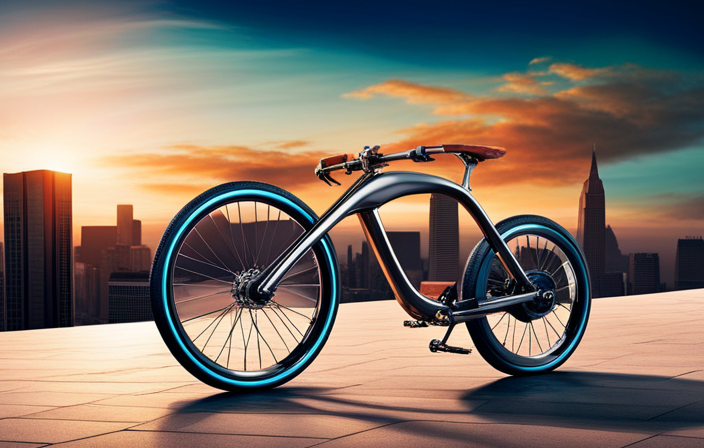
 Electric Bike3 weeks ago
Electric Bike3 weeks agoHow To Turn Your Bike Into An Electric Generator
-

 Vetted4 months ago
Vetted4 months ago15 Best Fixed Gear Bikes for Urban Commuting and Stylish Riding
-
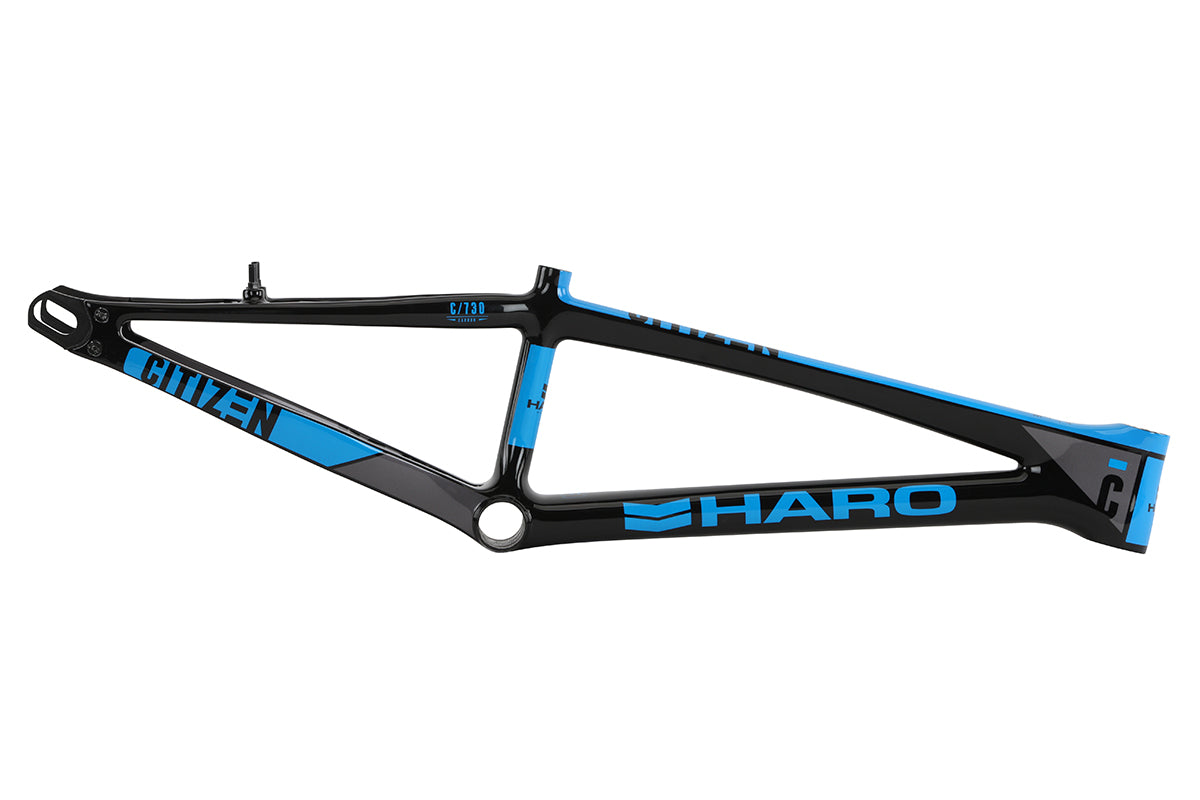
 Bike4 months ago
Bike4 months agoAdvantages and Disadvantages of a Carbon Fiber Bike Frame
-

 Vetted5 months ago
Vetted5 months ago15 Best Cycling Jerseys for Men to Elevate Your Riding Game
-

 Vetted5 months ago
Vetted5 months ago15 Best Cycling Gloves for Comfort and Performance – Ultimate Guide for Cyclists
-
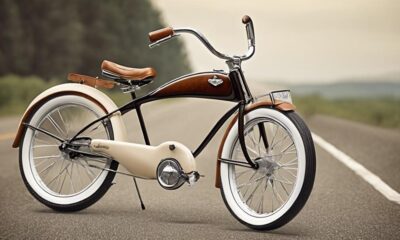
 Vetted4 months ago
Vetted4 months ago15 Best Cruiser Bikes to Hit the Road in Style
-
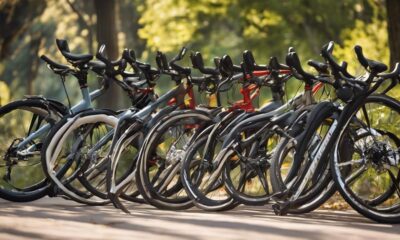
 Vetted4 months ago
Vetted4 months ago15 Best Comfort Bikes for a Smooth and Enjoyable Ride
